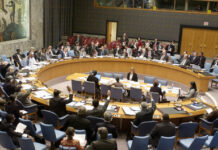Photo Credit: Global Diaspora News (www.GlobalDiasporaNews.com).
In recognition of Mental Health Awareness during the month of May, USCRI recognizes the importance of prioritizing mental health as fundamental to overall well-being, fostering public education, eliminating stigma, and normalizing the practice of taking moments, big and small, to attend to our mental health without feeling shame or guilt.
Many refugee service providers enter the field with the intent of helping others and providing compassionate and empathetic care for migrant and refugee clients with significant needs. Refugee service providers play a key role in providing direct assistance to refugees to ensure that their basic needs are met and assisting them in rebuilding their lives. The services provided by those who work with migrant and refugee populations inevitably involves listening to, bearing witness to, and to some degree, absorbing the pain and suffering of refugee clients. Work that involves witnessing a great deal of pain, either by observing or listening to the narratives of extreme stress and trauma, can result in lasting emotional distress and high rates of occupational hazards, such as burnout, or trauma-related stress conditions, like secondary traumatic stress (STS), compassion fatigue, or vicarious traumatization. In addition, organizational issues, such as high workloads or caseloads, lack of supervision, lack of work autonomy, and lack of professional support, are associated with an increased risk of burnout, secondary traumatic stress, and vicarious traumatization (Akinsulure-Smith et al., 2018; Kulkarni et al., 2013; Rauvola et al., 2019).
Professional Burnout
Professional burnout is a consequence of chronic work-related stress and is characterized by the presence of three primary features: 1) emotional exhaustion; 2) depersonalization and cynicism, defined as a negative attitude towards clients, personal detachment, or loss of ideals; and 3) feelings of inefficacy, including reduced personal accomplishment and commitment to one’s profession (Akinsulure et al., 2018). As a more general phenomenon that can occur within any professional setting, burnout is typically associated with working conditions and organizational stressors, such as long working hours, intense work demands, lack of work-life balance, lack of work autonomy, unclear expectations, lack of support or adequate supervision, and a lack of appreciation and reward (Akinsulure-Smith et al., 2018; Kulkarni et al., 2013).
Secondary Traumatic Stress (STS)
STS refers to the stress reactions induced in service providers following exposure to clients’ traumatic material. It is the “natural and consequential behaviors and emotions resulting from knowing about the traumatizing event experienced by a significant other (or client) and the stress resulting from helping or wanting to help a traumatized or suffering person” (Figley, 1995, p. 7). The symptoms of STS usually have a rapid onset and mirror the symptoms of posttraumatic stress disorder (PTSD) experienced by the primary survivor of trauma and include, intrusive thoughts, traumatic memories or nightmares associated with the client’s trauma, insomnia and other sleep problems, chronic irritability or angry outbursts, fatigue, difficulty concentrating, avoidance of clients and client situations, and hypervigilance or startle reactions. Research has estimated that rates of STS among refugee service providers are between 22.9% and 38%, with approximately 8.6% to 11% of refugee service providers demonstrating severe symptoms of STS (as cited in Ebren et al., 2021).
Compassion Fatigue
Compassion fatigue is a syndrome consisting of a combination of the symptoms of STS and professional burnout. It is a state of emotional distress and exhaustion and biological, psychological, and social dysfunction (Rauvola et al., 2019). Day-to-day bureaucratic hurdles combined with the chronic use of empathy can lead to the experience of compassion fatigue. Whereas STS has more of an immediate onset, compassion fatigue typically occurs cumulatively over time (Rauvola et al., 2019). Compassion fatigue not only affects physical and emotional health and job satisfaction, but it also affects the workplace by decreasing quality of work, productivity, client satisfaction, and increased turnover.
Vicarious Traumatization (VT)
VT refers to “a process of [cognitive] change resulting from [chronic] empathetic engagement with traumatic survivors” (Pearlman, 1999, p. 52). VT refers to the negative cognitive shifts in beliefs and thinking – the way one views and makes sense of the world – as a result of the cumulative effects of working directly with survivors of trauma. These cognitive shifts can occur to one’s sense of self (i.e., no longer believing in one’s ability to help others), one’s worldview that can potentially affect one’s sense of safety, sense of control, or the ability to trust oneself and/or others, or one’s spiritual beliefs (i.e., loss of meaning and feelings of despair). VT has been associated with interruptions in intimate relationships, the development of negative coping strategies, enhanced personal stress, trauma history, and decreased professional experience (as cited in Rizkalla & Segal, 2020). Although STS and VT have similar defining features, a useful distinction between them is to conceptualize VT as more pervasive and longer-lasting cognitive change process resulting in alterations in thoughts and beliefs about the world, whereas STS places more emphasis on the outward emotional and behavioral symptoms.
Coping Strategies
There are several effective coping strategies that refugee service providers can use to manage physical or emotional reactions that are triggered by clients’ trauma. Symptoms that may indicate being triggered include, sudden emotional reaction or change in mood, confusion or dissociation, intrusive thoughts, hypervigilance, panic, rapid and shallow breathing, rapid heart palpitations, shaking, muscle tension, or tunnel vision. The goal of these coping strategies is to reduce stress, regulate emotional states, and/or induce mind-body balance. It is important to keep in mind that there is no single coping strategy that works for everyone, so experiment with them to find the ones that work best.
Breathing Techniques. When we start to feel anxious, upset, or uncomfortable, our breathing is one of the first things that changes, usually becoming faster, shallower, and less smooth. Diaphragmatic or belly breathing is one technique that involves making a conscious change in our breathing rate and depth that will then signal to the brain and body that we are safe, allowing our whole system to calm down. Breathing techniques are simple, but powerful strategies that can be practiced for as little as two to three minutes a day. There are many different breathing techniques to try including, pursed lip breathing, lion’s breath, alternate nostril breathing, 4-7-8 breathing, or box breathing.
Grounding Techniques. When we are feeling overwhelmed or in distress, we can use grounding techniques to calm down, regain a sense of control, bring us back to the present moment, and improve our capacity to tolerate uncomfortable feelings. Grounding techniques are a set of short-term strategies that can be used anywhere and anytime we feel triggered or overwhelmed. The key element is to shift our attention away from flashbacks, intrusive memories or thoughts, and challenging emotions so that we feel safely anchored in the present. Try different grounding techniques to find the ones that are most helpful and then practice them while in a calm state, so you are ready to use them during times of stress. Grounding techniques are divided into two specific approaches: sensory awareness (i.e., using the five senses) or mental/cognitive awareness (i.e., mental distractions). For example, the 5-4-3-2-1 grounding technique uses the five senses to list things you notice around you (i.e., 5 things you can see, 4 things you can hear, etc.).
Relaxation Techniques. Relaxation techniques activate the body’s natural relaxation response that puts the brakes on stress, slows down breathing and heart rate, lowers blood pressure, and brings the body and mind back into balance. Examples of relaxation techniques include, body scan, progressive muscle relaxation, mindfulness, or yoga.
Self-Care
Self-care is an integrated and holistic approach to the promotion of resiliency and wellness. Self-care refers to the activities and practices we engage in regularly and intentionally to reduce stress and maintain and enhance our health and well-being in the short- and long-term. It is important to understand that self-care is not an indulgence or a form of pampering or spoiling oneself but rather it is essential to our overall health and to effectively providing care and services to clients. Self-care can include activities that offer distraction and/or personal growth, like journaling or being in nature, or activities that foster fun, rest, and relaxation, like exercise, adequate sleep, or gardening.
Social Support
One of the most robust correlates of well-being and recovery from traumatic stress is social support (Pearlman & Caringi, 2009). Refugee service providers who create personal and professional support networks are less likely to experience occupational hazards or trauma-related stress conditions and more likely to find their jobs and lives more fulfilling. By intentionally defining and building one or more support networks that serve to promote personal and professional well-being through interpersonal connections, refugee service providers gain some inoculation to the adverse effects of working with populations who have experienced trauma.
Organizational Support
Research evidence suggests that self-care alone is insufficient to mitigate staff stress and that organizational interventions to lower stress and provide greater staff support are vital (Rauvola et al., 2019). Refugee serving organizations should consider the following recommendations to provide vital support to their staff:
- All potential staff should be educated about the general risks and stressors of their work during onboarding. All staff should receive ongoing training on sources of stress, how to recognize the signs and effects of stress, burnout, STS, compassion fatigue, and VT, how to manage and cope, and preparation for dealing with the emotional responses of clients who have experienced traumatic events.
- Organizations should integrate staff support into their operational framework and include responses to routine sources of stress and unexpected stressful circumstances in policies.
- Organizations should strive to create a people-focused work culture of self-care and compassion where both the positive and negative aspects of an occupation are recognized, stress management resources are visible and accessible, and work-life balance is encouraged and supported.
- Ongoing trauma-informed supervision can be a powerful source of support in identifying and managing occupational hazards and stress-related conditions, as well as promoting staff engagement and empowering and satisfying the needs of staff.
- Provide opportunities for staff to connect through peer support and team building.
- Ensure that workloads/caseloads are reasonable and diversified by creating opportunities for staff to vary their duties, alleviate heavy caseloads, and have flexible scheduling and work arrangement options.
Given the current and ongoing global refugee crisis, refugee service providers are at a heightened risk for burnout, STS, compassion fatigue, VT, and other mental health problems. Refugee work can also be deeply rewarding, meaningful, and life-changing for service providers who are able to effectively manage work-related stressors and feel supported and valued in their work. During #MentalHealthAwarenessMonth, refugee service providers are encouraged to take time to evaluate and nurture their mental health regularly in order to enhance personal and professional well-being and resilience and provide the highest quality care to refugee clients and their families.
For more information about burnout, STS, compassion fatigue, and VT, please see below:
- Secondary Traumatic Stress, The Administration for Children and Families: information and intervention strategies.
- The American Institute of Stress: webinars, self-assessment, podcast, and more.
- Professional Quality of Life (ProQOL), managed by the Center for Victims of Torture: health assessment, manuals, and handouts.
- Secondary Traumatic Stress (STS) Consortium: information gathered by and for researchers, trainers, practitioners, and advocates.
References
Akinsulure‐Smith, A. M., Espinosa, A., Chu, T., & Hallock, R. (2018). Secondary traumatic stress and burnout among refugee resettlement workers: The role of coping and emotional intelligence. Journal of Traumatic Stress, 31(2), 202-212.
Ebren, G., Demircioglu, M., & Çirakoglu, O. C. (2021). A neglected aspect of refugee relief work: Secondary and vicarious traumatic stress. Journal of Traumatic Stress, 35(3), 891-900.
Figley, C. R. (1995). Compassion fatigue: Toward a new understanding of the costs of caring. In B. H. Stamm (Ed.), Secondary traumatic stress: Self-care issues for clinicians, researchers, and educators (pp. 3–28). The Sidran Press.
Kulkarni, S., Bell, H., Hartman, J. L., & Herman-Smith, R. L. (2013). Exploring individual and organizational factors contributing to compassion satisfaction, secondary traumatic stress, and burnout in domestic violence service providers. Journal of the Society for Social Work and Research, 4(2), 114-130.
Pearlman, L. A. (1999). Self-care for trauma therapists: Ameliorating vicarious traumatisation. In B. H. Stamm (Ed.), Secondary traumatic stress: Self-care issues for clinicians, researchers, & educators (pp. 51-64). Sidran Press.
Rauvola, R. S., Vega, D. M., & Lavigne, K. N. (2019). Compassion fatigue, secondary traumatic stress, and vicarious traumatization: a qualitative review and research agenda. Occupational Health Science, 3, 297-336.
Rizkalla, N. & Segal, S. P. (2020). Refugee trauma work: Effects on intimate relationships and vicarious posttraumatic growth. Journal of Affective Disorders, 276, 839-847.
The post Mental Health Awareness Month: Managing Occupational Hazards For Refugee Service Providers appeared first on USCRI.
Source of original article: U.S. Committee for Refugees and Immigrants (refugees.org).
The content of this article does not necessarily reflect the views or opinion of Global Diaspora News (www.GlobalDiasporaNews.com).
To submit your press release: (https://www.GlobalDiasporaNews.com/pr).
To advertise on Global Diaspora News: (www.GlobalDiasporaNews.com/ads).
Sign up to Global Diaspora News newsletter (https://www.GlobalDiasporaNews.com/newsletter/) to start receiving updates and opportunities directly in your email inbox for free.
































